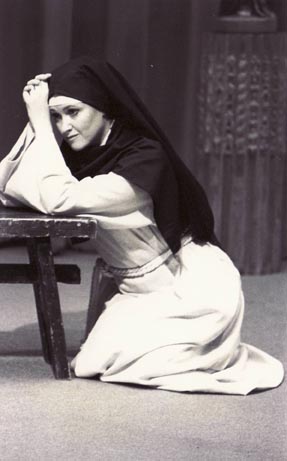Suor Isabella (1982)
Comic Opera in One Act
Libretto in English by Daniel Dibbern
Based on a story from The Decameron by Giovanni Boccaccio
See also Favola Boccaccesca
Duration: 70 minutes
Cast: 2S, 2Mz, Women’s SSA Chorus or 3 Soloists
fl(pic).cl(bcl)/tpt.btbn/perc/hp.pf/vn/vc
Piano reduction available
Commissioned by the National Endowment for the Arts
Suor Isabella is a ribald companion piece to Puccini’s classic, Suor Angelica. The two works may be performed with the same cast, sets and costumes. The title character, Sister Isabella, is a beautiful young nun who sneaks a man into her cell. The other nuns gleefully report Isabella to the Mother Superior who, having a lover of her own (a priest), dresses hurriedly in the dark, covering her head not with her veil but with the priest’s trousers! When all is discovered, the Mother Superior forgives Isabella and the nuns praise the joy of human love as a reflection of divine love.
Soprano Susan Barrow as Suor Isabella at UT Dallas (1982)
 Reviews:
Reviews:
... hilarious... written tightly, is full of action and is genuinely funny...There is no reason to think that Suor Isabella will not have a huge success, nor that this earthy little buffa might not have a happy life on television.
Patsy Swank, The Dallas
Downtown News
Highly original; superior music - humorous, moody, emotional, appealing, uplifting; dramatic, clever, funny lyrics; commercially viable; could adapt to a university setting or to a smaller house.
National Music
Theater Network
... does considerable justice to the subtleties of Boccaccio’s
richly human tale...Medieval roots pervade Suor Isabella.
A famous saltarello (you'll find it on practically every recording of
Medieval dance music) appears as a recurring thread, distorted in all
manner of ingenious ways... Thus his 70-minute opera views the Medieval
world through 20th-century eyes and ears, and does so colorfully, engagingly...
Derrick Henry, The Boston Globe
... a new member of the standard repertory!
Phyllis Curtin, The Metropolitan Opera
Program Note:
Commissioned by the National Endowment for the Arts, Suor Isabella (Sister Isabella) is a one-act comic opera. It is based on a tale from The Decameron by Giovanni Boccaccio (1313-1375). Written around 1348, The Decameron is a collection of 100 tales told over a period of ten days by a group of ten young Florentines who have fled to a country estate to escape the great Black Death plague. (The format was borrowed by Chaucer, a great admirer of Boccaccio, when he wrote The Canterbury Tales some forty years later.)
Funny, audacious, sometimes ribald, always irreverent, the stories delight in deflating the self-important and exposing the hypocritical, with representatives of the church as favorite targets. Boccaccio’s master-piece, this collection of tales marks him as one of the earliest and greatest of the humanists. It is this quality of lively and pungent humanity that makes The Decameron always fresh, and which the opera seeks to capture.
The score of the opera draws heavily upon Medieval roots in matters of structure as well as in the use of actual Medieval melodies woven into the musical texture. Inspired by early mensuration canons, the rhythmic patterns range from simple 2:1 ratios to several complex contrapuntal layerings of cross rhythms. One long rhythmic unit, used in connection with the priest in the trunk, is given special prominence and treated as a large musical building block which is made to recur in accordance with Ars Nova isorhythmic techniques.
Of the actual quotations employed, the most important is a famous Saltarello (or “jumping dance”) of Boccaccio’s time. It is this tune which generates the opera’s irreverent subtitle, Il Saltarello de’ Veli (The Dance of the Veils): a musical pun on the Italian saltarello (or “psaltery of veils”) worn by nuns of the period ; and it is of the many layers of variants and counter-melodies added to the tune that the main musical material of the work consists. This secular tune contrasts with several more decorously ecclesiastical melodies which are developed in a similar fashion. These include a Cunctipotens genitor, the Spanish Quen la Virgen, a highly disguised fragment of the Dies Irae and, appropriately for the Mother Superior, a hymn of St. Ambrose originally composed to combat heresy. Bell patterns heard by the composer in the village churches near Bellagio, Italy are quoted near the opening of the work and near its close.